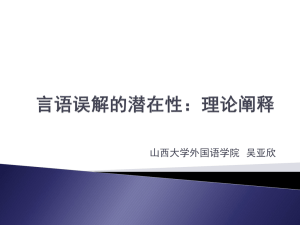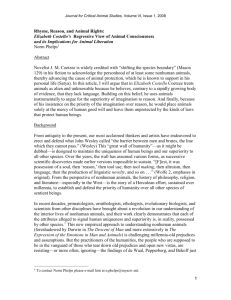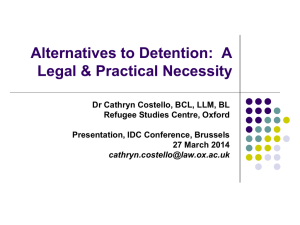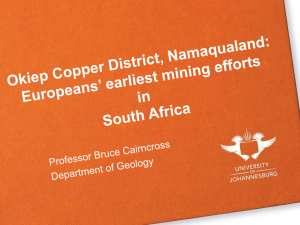Ethics of Embodiment, seminar abstract
advertisement
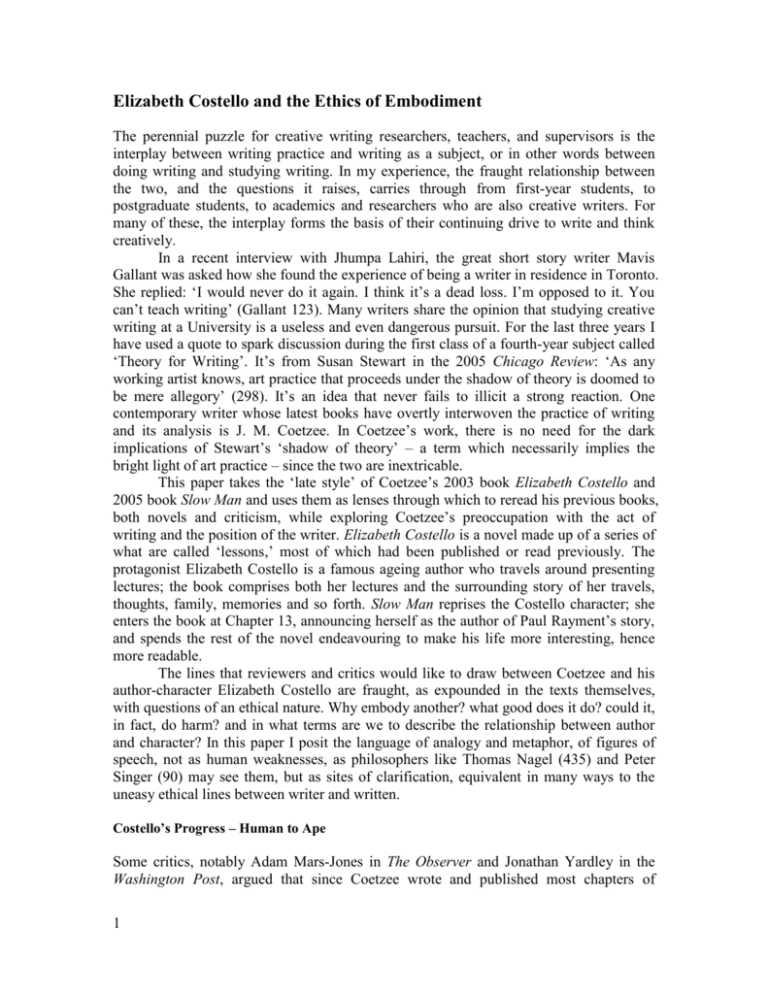
Elizabeth Costello and the Ethics of Embodiment The perennial puzzle for creative writing researchers, teachers, and supervisors is the interplay between writing practice and writing as a subject, or in other words between doing writing and studying writing. In my experience, the fraught relationship between the two, and the questions it raises, carries through from first-year students, to postgraduate students, to academics and researchers who are also creative writers. For many of these, the interplay forms the basis of their continuing drive to write and think creatively. In a recent interview with Jhumpa Lahiri, the great short story writer Mavis Gallant was asked how she found the experience of being a writer in residence in Toronto. She replied: ‘I would never do it again. I think it’s a dead loss. I’m opposed to it. You can’t teach writing’ (Gallant 123). Many writers share the opinion that studying creative writing at a University is a useless and even dangerous pursuit. For the last three years I have used a quote to spark discussion during the first class of a fourth-year subject called ‘Theory for Writing’. It’s from Susan Stewart in the 2005 Chicago Review: ‘As any working artist knows, art practice that proceeds under the shadow of theory is doomed to be mere allegory’ (298). It’s an idea that never fails to illicit a strong reaction. One contemporary writer whose latest books have overtly interwoven the practice of writing and its analysis is J. M. Coetzee. In Coetzee’s work, there is no need for the dark implications of Stewart’s ‘shadow of theory’ – a term which necessarily implies the bright light of art practice – since the two are inextricable. This paper takes the ‘late style’ of Coetzee’s 2003 book Elizabeth Costello and 2005 book Slow Man and uses them as lenses through which to reread his previous books, both novels and criticism, while exploring Coetzee’s preoccupation with the act of writing and the position of the writer. Elizabeth Costello is a novel made up of a series of what are called ‘lessons,’ most of which had been published or read previously. The protagonist Elizabeth Costello is a famous ageing author who travels around presenting lectures; the book comprises both her lectures and the surrounding story of her travels, thoughts, family, memories and so forth. Slow Man reprises the Costello character; she enters the book at Chapter 13, announcing herself as the author of Paul Rayment’s story, and spends the rest of the novel endeavouring to make his life more interesting, hence more readable. The lines that reviewers and critics would like to draw between Coetzee and his author-character Elizabeth Costello are fraught, as expounded in the texts themselves, with questions of an ethical nature. Why embody another? what good does it do? could it, in fact, do harm? and in what terms are we to describe the relationship between author and character? In this paper I posit the language of analogy and metaphor, of figures of speech, not as human weaknesses, as philosophers like Thomas Nagel (435) and Peter Singer (90) may see them, but as sites of clarification, equivalent in many ways to the uneasy ethical lines between writer and written. Costello’s Progress – Human to Ape Some critics, notably Adam Mars-Jones in The Observer and Jonathan Yardley in the Washington Post, argued that since Coetzee wrote and published most chapters of 1 Elizabeth Costello separately, there is little to substantiate a novel, little development, little that abides: ‘Coetzee seems simply hamstrung by the hybrid status of his inventions’ (Mars-Jones 2003). I would argue, however, that at the heart of each lesson is a cluster of close-knit ideas centred on the notion of embodiment which we find entangled with authorial imagination; surrounding them is the proposal that literature is an appropriate medium to discuss matters outside the realm of reason. These four terms – embodiment, imagination, literature, reason – Coetzee returns to repeatedly throughout the novel. Here, Lessons 3, 4 and 6 emerge as prominent in addressing these central themes, and indeed are the most forcefully memorable chapters of the book. In Lesson 3, the first part of the double-Lesson on ‘The Lives of Animals,’ a short story by Franz Kafka provides Costello with a landscape for her argument. It is Kafka’s ‘A Report to an Academy’, an address by Red Peter, an ape trained to be human. Costello admits to feeling a little like Red Peter as she stands before a theatre of academics there to adulate her life’s achievements. She wants to talk about animals: why it is wrong that they should suffer at the hands of human industries, and wrong, indeed, that they should be bred in order to be killed and their flesh eaten. To talk about these matters, however, to a roomful of academics, requires tact and an appropriate language, a language Costello knows is available to her: It is the language of Aristotle and Porphyry, of Augustine and Aquinas, of Descartes and Bentham, of, in our day, Mary Midgley and Tom Regan. It is a philosophical language in which we can discuss and debate what kind of souls animals have, whether they reason…whether they have rights in respect to us’ (Coetzee, Costello 66). When Peter Singer responded to this lecture as delivered by Coetzee at Princeton University in 1998, it was the response of a philosopher using philosophical language. Even when Singer attempted a fictional dialogue with his daughter Naomi, as an element of his reply, the ‘conversation’ is quickly exposed as the means towards the wellreasoned end: Naomi: I can see what she’s getting at. When you kill a bat, you take away everything that the bat has, its entire existence. Killing a human being can’t do more than that. Peter: Yes, it can…The value that is lost when something is emptied depends on what was there when it was full, and there is more to human existence than there is to bat existence. (Singer in Coetzee Lives of Animals 90) Singer illustrates his point using an analogy of two liquids being poured down the sink, first a carton of soymilk, then a bottle of Kahlúa liqueur, to demonstrate that, when spilt, one has more value (at least to his daughter) than the other. There is a distinction to be made here between the philosophical use of analogy and the use of metaphor, the one seeking to clarify, the other paving the way for subversion, the poetic, or ‘analytic symbolism’ as Lacan had it (Lacan 53). Singer’s attempted abstraction of the two glasses as an illustrative analogy seems counterproductive here in response to a lecture about 2 fiction and embodiment. In her lecture, Costello offers, as an alternative to the indirect abstraction of analogy – it is like, what if I was holding, it is comparable to – the direct verb is: the language of metaphor. She also suggests that the two – analogy and metaphor – are not so remote from each other as their apparently apposite descriptive purposes might suggest. In fact, she moves between the two phrases ‘it is like’ and ‘it is’ with fluency: ‘For instants at a time…I know what it is like to be a corpse… For a moment we are that knowledge. We live the impossible: we live beyond death.’ Later she continues, ‘Do I know what it is like for me to be a corpse or do I know what it is like for a corpse to be a corpse? The distinction seems to me trivial…For an instant…I am alive inside that contradiction, dead and alive at the same time’ (Coetzee, Costello 76-7). Here Costello’s call for literature as an alternative to philosophy and reason is evident through her conflation of analogy and metaphor: she suggests that the subversion and ‘making poetic’ of metaphor is, in fact, the way to clarification. Where science and philosophy use analogy – as Singer used the two glasses – as a tool towards clarification, Costello posits analogy and metaphor – linguistic figures of speech – as the actual sites of clarification. Singer does not enter his own analogy, does not, as Costello does with her corpseself, become that knowledge. The same can be said of Singer’s attempt at creating a fictional dialogue between two characters – he does not enter his fiction; we finish the discourse with no insight into the characters of Peter and Naomi, no awareness of their setting, position, relationship. Quite simply, we do not believe that they are people, in a fictional sense. Like the character of Norma, Costello’s daughter-in-law, who has ‘very proper doubts’ about Costello’s lectures, and who voices ‘all the obvious objections’ (Singer in Lives of Animals 91), Singer’s ‘characters’ are mouthpieces for reasonable arguments. The intriguing aspect of Elizabeth Costello, the thing, perhaps, that has made her so difficult to get rid of – or ‘take care of’ – is the fact that she is not defined by her arguments, instead the arguments are defined by her. She somehow clambers out of realism to enter the real, and this is the central development which ties each lesson to the next. Singer’s dialogue is just the kind of language Costello wants to resist in her discussion of animals. Just as Red Peter the ape was taught to reason as a human reasons, taught that reason was the very function that separates ape from human, Costello feels she too, simply by the weight of human history, is forced to accept reason is, as she puts it, ‘the being of the universe’. Whereas it is her contention, and deep feeling, that reason is a much more specific occurrence: ‘Reason is the being of a certain spectrum of human thinking’ (Coetzee, Costello 67). In Kafka’s story Red Peter speaks of finding it difficult to remember his life as an ape, of his memory closing behind him like a door: ‘I could have returned at first, had human beings allowed it, through an archway as wide as the span of heaven over the earth, but as I spurred myself into my forced career, the opening narrowed and shrank behind me’ (Kafka 147). It is an apt metaphor for what Costello is also saying about the options of human thinking. She contends that when philosophers like Nagel argue we can never know ‘what it is like for a bat to be a bat’ (Nagel 437), we are restricting ourselves, allowing that wide archway of possibility to close behind us until what we have is one narrow passageway: reason. Costello offers the alternative: embodiment. ‘To thinking, cogitation, I oppose fullness, embodiedness, the sensation of being…This fullness 3 contrasts starkly with Descartes’ key state, [cogito, ergo sum] which has an empty feel to it: the feel of a pea rattling around in a shell’ (Coetzee, Costello 78). The difference between writers and philosophers is also observed in Lesson 1, when Costello’s son John watches his mother go through the motions of another radio interview and mulls: ‘A writer, not a thinker. Writers and thinkers: chalk and cheese. No, not chalk and cheese: fish and fowl. But which is she, the fish or the fowl? Which is her medium: water or air?’ (Coetzee, Costello 10). These last two questions draw attention again to the particular undertaking of the writer: to enter metaphor, not as symbol, but as embodied nature; the water and the air not as abstractions, but wet or windy reality. It is Costello’s, and my own, opinion that the chalk and the cheese, writers and thinkers, can occupy the same page and indeed the same classroom. Throughout Lesson 4, Costello reiterates the contrast, this time using poems by Rilke and Ted Hughes to expound upon the difference between writing an animal as a symbol, and writing an animal, as Costello says Hughes does, ‘feeling his way towards a different kind of being-in-the-world’ (Coetzee, Costello 95). It is, however, when the reader reaches Lesson 6 that Costello’s argument for embodiment encounters a question which challenges the straightforward dualism it has remained confined to so far. The question: is it ever morally wrong to push or press oneself into imagining the being of another? The Dark Chamber: Ethics and Ambiguity In the 2006 film Capote which dramatises Truman Capote researching and writing his non-fiction masterpiece In Cold Blood, the filmmakers also present, with deliberation, the moral dilemma of the author. The film cuts from scenes in which Capote interviews a murderer with a lover’s tender concern, to scenes of his New York literary triumph and festivities in high society. This sort of juxtaposition also concerns Elizabeth Costello, and echoes back through Coetzee’s books, particularly to the figure of Dostoevsky in Master of Petersburg: the author thrives on pain, the author may even go so far as to manipulate the true pain of others in order to create his best work. In the film it is implied that Perry Smith not only murdered his victims in cold blood, but that Capote also wrote, and maybe shortened a life, in cold blood; perhaps that the filmmakers themselves threaded the reels cold-bloodedly. When Smith is hanged Capote, we assume, cannot help but wonder if he hastened the end of this life in order to find an end for his novel. A scene of hanging is also at the centre of Paul West’s book The Very Rich Hours of Count von Stauffenberg, the book that Elizabeth Costello has just finished reading when we find her in Lesson 6. Costello is deeply disturbed by the book: she feels it to be ‘sick,’ ‘depraved,’ ‘obscene,’ and finally lands upon ‘the sturdy Calvinist word evil’ (Coetzee, Costello 157–9), to describe the text, particularly the scenes she relates involving the execution of Hitler’s would-be assassins. Before she arrives at these chapters, she reflects, ‘all was going well enough,’ implying that it was only those few horrifying scenes that affected her judgement of the book as a whole. In fact if one reads West’s book one finds the scenes of horror to be brief in comparison with the bulk of the text which is a minutely-crafted portrayal of an historical event: the individuals, episodes and social implications. The weight of those scenes of horror, then, relative to the book as a whole, is enormous. For Costello, the plot, narrative and general course of the book are 4 overshadowed by the ‘evil’ in those short scenes: she cannot think of the book as a book anymore, but as the scene of a violence done to her. This strange relative weight will be discussed in greater detail presently. For now, I will explore some of the ethical predicaments, or at least questions, that Coetzee’s Lesson 6 presents. This is the place in the novel when the cluster of linked themes – embodiment, imagination, literature and reason – reaches a point of crisis and is pushed forward, indicating Costello’s progression as a character. There is first of all the question of whether literature, and art in general, should necessarily come under moral scrutiny, or whether, as Costello used to believe in her former, more liberal paper, that ‘the civilization of the West is based on belief in unlimited and illimitable endeavour, it is too late for us to do anything about that’ (Coetzee, Costello 160). Should there, in fact, be limits upon what is presented artistically, she now wonders, and should the worth of art be judged on its ethics? In his 1998 essay ‘The Ethical Criticism of Art,’ which appears in two major anthologies on the philosophy of literature, Berys Gaut introduces the term ethicism as ‘the thesis that the ethical assessment of attitudes manifested by works of art is a legitimate aspect of the aesthetic evaluation of those works’ (Gaut 355). In clarifying his definition Gaut keeps ethicism and censorship distinct: ‘All that follows from ethicism is that if a work manifests morally bad attitudes it is to that extent aesthetically flawed, flawed as a work of art. The fact that a work of art is aesthetically flawed is not grounds for its censorship’ (Gaut 356). Although in Lesson 6 Costello is not so much concerned with an author’s obscured particular moral attitudes, but more with a kind of general meta-ethics, Gaut’s expression is worth exploring for the light it might shed on the issues tackled throughout Elizabeth Costello. Ethical assessments of art can be found in almost all modern reviews, their task being, unlike literary criticism, to provide a judgement of a work for a wide audience. These ethical appraisals can be as simple as a particular word-choice. The word ‘important,’ for instance, which is used frequently by reviewers to describe a film, book, artwork or musical work which addresses some defining historical event, places the work on an ethical level and inevitably indicates the reviewer’s assessment of it. Even if they are not entirely impressed with the artistry of the work, the reviewers are influenced in their evaluation by the significance of its ethical stance. Sometimes reviewers are torn between the work’s ethical and artistic merits, and in the end their assessment reflects their attitude to each. A number of Coetzee’s novels have received a similar mixed response, most notably 1980’s Waiting for the Barbarians and 1999’s Disgrace, the former being undoubtedly Coetzee’s most graphically violent and perhaps darkest work, the one that crystallized his importance as a novelist, in fact (Head 72). The books each received numerous awards, but were met by reviewers with wariness. All recognised the books’ artistic merits, the haunting nature of their allegories, their disconcerting central male figures, their stylistic beauty. What made reviewers uneasy was the dislocation of the texts. What some were not sure of, it seems, was, ‘Is he, or is he not, making a point about the current state of South Africa? And if he is, then why veil the point; why the metaphor?’ As Schott wrote of Barbarians: ‘It moves tentatively and conditionally, and most often in the direction of irony and ambiguity’ (Schott 2). And even more damning, Peter Lewis from the Times Literary Supplement, ‘This kind of fiction as a whole, peopled as it is mainly by stereotypes, is often in danger of moving so far away from the 5 familiar in its determination to establish universals that it defeats its own purpose’ (Lewis 1270). Is the recognisably ethical and political nature of the novels what, in fact, establishes them as ‘important,’ or ‘good’? And are these reviewers accusing Coetzee of a coy avoidance of his ethical responsibilities to the specificity of immorality? To place this discussion in a further context, the idea of embodiment must be more broadly introduced. In a 1986 essay entitled ‘Into the Dark Chamber,’ Coetzee wrote about his book Waiting for the Barbarians in relation to its themes of torture. He writes plainly, perhaps riskily so, about Vorster Square, the Headquarters of the Johannesburg security police: Let us be clear about the situation of the prisoner who falls under suspicion of a crime against the state. What happens in Vorster Square is nominally illegal… What the prisoner knows, what the police know he knows, is that he is helpless against whatever they choose to do to him. The torture room thus becomes like the bedchamber of the pornographer's fantasy where, insulated from moral or physical restraint, one human being is free to exercise his imagination to the limits in the performance of vileness upon the body of another. (Coetzee ‘Dark Chamber’ 13) The phrase that leaps at once from the page, if one is alert to the simile being evinced, is ‘free to exercise his imagination to the limits.’ Such a positive phrase, one used, probably, in many art, film, music and creative writing classes, ‘Feel free to exercise your imagination here.’ It is no mistake that Coetzee uses it here to describe the torturer and his dark chamber. This is the very place, in fact, where the novelist finds inspiration, simply because of its inaccessibility. Coetzee quotes John T. Irwin’s book Doubling and Incest/Repetition and Revenge on the character of the novelist: It is precisely because [he] stands outside the dark door, wanting to enter the dark room but unable to, that he is a novelist, that he must imagine what takes place beyond the door. Indeed, it is just that tension toward the dark room that he cannot enter that makes that room the source of all his imaginings – the womb of art. (qtd. in Coetzee ‘Dark Chamber’ 14) Again it is the idea of inaccessibility, the inhuman, just like Nagel’s pronouncement of the inaccessibility of the life of a bat, that sparks the author’s creative curiosity, and his desire for embodiment. But the difference between trying to embody a bat, a tiger, an ape, as distinct from a torturer or a hangman, or indeed a man hanged, is, in the end, an ethical one. This is, I argue, where the progression of Elizabeth Costello’s themes comes into play: the lessons are not only linked by a cluster of correlated ideas – embodiment, imagination, literature and reason – they are moving toward something, and here the shift from Lessons 3 and 4 to Lesson 6 is a progression from asking how? and whether? to asking why? and why not? Costello’s impassioned argument for embodiment and literature over reason and philosophy becomes embroiled, in Lesson 6, in the question of moral limitation. At the same time as Costello is enunciating this progression, the reader is aware of the same questions with relation to Coetzee’s ‘embodiment’ of his subject, 6 Costello. The reader may perhaps begin by asking how Costello and Coetzee are similar, whether they are, in fact, two parts of the same whole; later, though, they may ask, as Paul West does in his review of Lesson 6 in Harper’s Magazine, why Coetzee chooses this woman as his subject, a woman with whom he has so much in common, but whose views on ethics, as West sees it, are the ironic opposite of Coetzee’s own: I found myself drawn sotto voce into the discreet spectacle of an author banishing a cantankerous ghost whose primal views he did not share but had nonetheless haunted him… Do the hints get through, then, enough to convince us he's on the side of West rather than Costello? I think so. Costello herself is made to claim that West will have “defenders by the thousand,” dubbing him “not a devil but a hero”. (West ‘Novelist and the Hangman’ 89) West is in a position unlike any other reader of the novel, in finding himself a (silent) character, and his book a catalyst towards Costello’s most controversial lecture in which she cautions bluntly: ‘I do not believe it will be good for you or for me to hear [from the ‘terrible pages’ of the book]… I do not believe it was good for Mr West…to write those pages’ (Coetzee, Costello 173). His picture, then, of Coetzee banishing a disagreeable ghost and dropping clues towards his actual support of West, comes from a unique readerly stance, and is indeed unique amongst appraisals of the Coetzee-Costello relationship. Most reviewers assume, with Peter Singer, that Costello is a kind of fictional alter-ego for Coetzee, a relationship which carries with it enough ambiguity to make Costello’s contentious views beyond reproach. Why, the obvious question emerges, as we progress from observing the relationship to interrogating it, would an author embody himself in fiction? Isn’t the high aim of writing a literary character to withdraw from the self in order to inhabit another? In fact, aren’t authors known for becoming rather tetchy if it is suggested they resemble their main characters? In the same article, West speaks affectionately of ‘Stauff,’ an historical figure West has fictionalised and now interacts with, hears speaking, after his death: ‘Lines, not mine, that fit Stauff (as I call him), if you are any sort of literary person, include ‘Unspeakable ... is the sorrow you bid me renew,’ from the opening lines of The Aeneid's second book’ (West ‘Novelist and the Hangman’ 92). In other words there is a sense in which Stauff is independent, and may protest his indecorous un-burial. The strange symbiosis between author and character is often one of mutual creation, but slips, as images do, from the peaceful still of two hands drawing each other, to the chaotic master-slave relationship of Sinbad and the old man. It is my contention that there is no easy line to be drawn from Coetzee to Costello, and no easy division either. Since the book is above all, in my view, a study of the writer, the writer’s life and processes, then surely part of that process is to experience what it is like to both embody a character and to emerge from that embodiment. The strange dipping from one state to another, one being to another, is at the heart of both Elizabeth Costello and Slow Man. The point that seems to be missed by those who would criticise Barbarians for its ambiguity or universality in relation to the contemporary issue of tyranny, is that the character of the magistrate is defined not only by his position in the frontier-town, but by 7 his position in the novel – that of narrator. The magistrate is an author figure – he too battles with the dark door: I know somewhat too much; and from this knowledge, once one has been infected, there seems to be no recovering. I ought never to have taken my lantern to see what was going on in the hut by the granary. On the other hand, there was no way, once I had picked up the lantern, for me to put it down again. The knot loops in upon itself; I cannot find an end. (Coetzee Barbarians 21) As such he is also, like Coetzee, engaged in this strange cyclic immersion and emergence, both entering and observing the characters and events around him. To be anything other than ambiguous would be to misrepresent the position of the divided author, as Coetzee sees it. Just like Coetzee’s other protagonist author-figures – Dostoevsky, Mrs Curren, Susan Barton – the magistrate is both the mouthpiece for allegorical summary, and a particular being with a body upon which detailed tortures may be enacted. Two Suspended Elements In Elizabeth Costello, desperation finds its voice in the Postscript, a letter from Lady Elizabeth Chandos to Sir Francis Bacon, in which she rails against the turmoil of metaphor. ‘It is like a contagion,’ she says, repeatedly, ‘Saying one thing always for another.’ In fact, the voice of Lady Chandos acts as one final dissenting call from Costello’s audience, asking, as it does, for relief from the endless cycles of words that never arrive at meaning. In a way, Lady Chandos is echoing the arguments of the philosophers, albeit in tones far removed from the measured sentences of Singer and Nagel. At the very beginning of his article ‘What is it like to be a bat?’ Nagel criticises the way many reductionist philosophers use analogies from modern science to expound their particular view of the mind-body problem. He writes: It is most unlikely that any of these unrelated examples of successful reduction will shed light on the relation of the mind to the brain. But philosophers share the general human weakness for explanations of what is incomprehensible in terms suited for what is familiar and well understood, though entirely different. (Nagel 435) This is the ‘human weakness’ Lady Chandos also baulks at, as she rejects, one after the other, her ‘wayfarer,’ her ‘flaming swords,’ her ‘dog in the sun,’ as diversions from the unutterable heart of her trouble. Yet Costello argues, and, I believe, Coetzee argues, that this is not a weakness at all, but a strength, the strength of literature and its power beyond philosophy. It is not the mind, reason, experience, or consciousness that open the passageway from one being to another, but that most flimsy and unfashionable of words, the heart: ‘The heart is the seat of a faculty, sympathy, that allows us to share at times the being of another. Sympathy has everything to do with the subject and little to do with the object’ (Coetzee, Costello 79). Sympathy, then, is the faculty or capacity for embodiment, as opposed to embodiment itself. Marion Bloom never existed, as Costello points out, but was brought to life, given an existence first by James Joyce and followed by Costello 8 herself, who also never existed, but was brought to life by Coetzee. If sympathy has ‘everything to do with the subject,’ then Costello is positioned as both sympathetic imaginer of another, and revelatory signpost to her creator, Coetzee. The two, author and character, are held in a suspended state, each engaged in the task of embodying another, each therefore designing a looping space from which to embody themselves. The self-same tension between author embodying character exists between metaphor and analogy – the contrasting space between the two complicates, subverts and enriches the apprehension of each. The purpose in each case, both literary embodiment and linguistic expression, is not the same as the purpose of the philosophers. It doesn’t reduce, it doesn’t offer an answer, it doesn’t explain. The purpose of these suspended distances is, in the end, the purpose of literature itself, the purpose of placing the pen to the page in an act of separation, multiplicity and metaphor: to create and imagine otherness, to renew and subvert perspective, to see things again, through the faculty of sympathy. Coetzee’s Elizabeth Costello texts, breaking away as they do from the steadier naturalism of his most famous book Disgrace, become examples of Derrida’s fictive narrativity: ‘Fiction of narration as well as fiction as narration: fictive narration as the simulacrum of narration and not only as the narration of an imaginary history’ (Derrida 199). Just as the novels both inhabit and observe their own narration, so too are their characters both inhabited – embodied – and observed, using the creative distance of metaphor. The same principle is thus at work at every level of the fiction. At the level of the sentence we find the distance between two elements of a metaphor. At the level of the narrative, we find embodiment, the author in suspense with her character. And at the level of text, we encounter the same principle of distance: the work itself in suspense between its narrative and its own narration. These observations about the positioning of two suspended elements at every level of the fiction carries with it further weight than mere structural arrangement. As two great ethical philosophers, Sartre and Levinas, have observed, the suspended distance between one and another is the basic condition for ethical responsibility, ethical response and ethical action. Sartre said in an interview in 1980, the year of his death: [By] ethics I mean that every consciousness…has a dimension…the dimension of obligation… By obligation I mean that at every moment that I am conscious of anything or do anything, there exists a kind of requisition… [that] results in the fact that the action I want to perform includes a kind of inner constraint…Everything that takes place for a consciousness at any given moment is necessarily linked to, and often is even engendered by, the presence of another. (Sartre and Lévy 87) Levinas used the image of the self facing another to discuss this same suspended state. As one commentator put it: ‘the self’s responsibility to the other who faces is immediate, originary, and irreducible’ (Robbins 1052). The moment of divide, then, when an author puts pen to paper, and when she attempts to make that leap towards embodying another, is fraught with questions of responsibility, obligation and constraint. The divides prompted by the moment of writing are multiple and varied, and each involves this same ethical positioning, one facing another: author faces reader, faces character, faces their own self-division. Authors are perhaps constantly weighing the equation in their minds: 9 is art worth this betrayal? Is this beauty? and if it is, then what is beauty’s value? Is beauty’s value worth someone’s life, is it worth their soul, is it worth their trust? In the Elizabeth Costello short story ‘As A Woman Grows Older,’ published the year after the novel was released, Costello mulls over the question of beauty with her art-dealer daughter: Is beauty not just another consumable, like wine? One drinks it down, it gives one a brief, pleasing, heady feeling, but what does it leave behind? The residue of wine is, excuse the word, piss; what is the residue of beauty? What is the good of it? Does beauty make us better people? (Coetzee ‘As a Woman’ 2004) When an author puts pen to page and comes face-to-face with another being, who holds her in suspense with herself, these questions about the weight and the worth of beauty, the weight of horror and ‘evil’, are always hovering around her pen. Can a horrific occurrence justify its own retelling, its transferral, its spread, because it lends itself to the beauty of form? Elizabeth Costello asks: Does it do us, or the author, any good? It is, perhaps, the wrong question, but in asking it Costello reveals herself to us, embodied, at times ‘like’ a real person and at times, a real person. We are both rational and irrational beings. Just as Coetzee both embodies and emerges from the embodiment of his character Costello, we also slip in and out of different states of being, now distancing ourselves in order to make reasonable comparisons, and now entering, embodying, another state, occupying its fullness of being. Who dares say, it is just a story, when at any moment an idea may shift from one ‘spectrum of human thinking,’ reason, to another, embodiment. As the distinction between realism and the real becomes tenuous, so do the lines of ethical responsibility. We arrive at the final Lesson, in which Costello, a fictional character, finds herself immersed in an overtly fictional world, but must still interact with this world, and answer to this world just as a real person in the real world might. We reread it with the idea of embodiment lingering in our minds and discover: our imagined selves are also answering to an imagined world; we are at times ‘like’ real people, and at other times, we are real people. It is unreasonable, it is just as real. --------Works Cited Coetzee, J. M. ‘As a Woman Grows Older.’ The New York Review of Books 15 Jan. 2004. http://www.nybooks.com/articles/16872. –––. ‘Fictional Beings.’ Philosophy, Psychiatry & Psychology 10.2 (2003): 134–134. –––. The Lives of Animals. Princeton: Princeton University Press, 1999. –––. ‘Into the Dark Chamber: The Novelist and South Africa.’ New York Times Book Review 12 Jan. 1986: 13–14. –––. Waiting for the Barbarians. Harmondsworth: Penguin, 1980. 10 Derrida, Jacques. ‘Before the Law.’ Acts of Literature. Ed. Derek Attridge. New York: Routledge, 1992. 181–220. Gallant, Mavis. and Lapiri, Jhumpa. ‘Interview.’ Granta 106: New Fiction Special, London: Granta, 2009. 103–155. Gaut, Berys. ‘The Ethical Criticism of Art.’ Philosophy of Literature: Contemporary and Classic Readings: An Anthology. Eds. Eileen John and Dominic Lopes Oxford: Blackwell, 2004. 355–362. Head, Dominic. J. M. Coetzee. Cambridge: Cambridge University Press, 1997. Kafka, Franz. ‘A Report to an Academy.’ Wedding Preparations in the Country and Other Stories. Trans. Willa and Edwin Muir. Harmondsworth: Penguin, 1958. Lacan, Jacques. ‘The function and field of speech and language in psychoanalysis.’ Écrits: A Selection. Trans. Alan Sheridan. London: Tavistock/Routledge, 1977. Lewis, Peter. ‘Types of tyranny.’ Times Literary Supplement 7 Nov. 1980: 1270–71. Marais, Michael. ‘J. M. Coetzee’s Disgrace and the task of the imagination.’ Journal of Modern Literature 29.2 (2006): 75-93. Mars-Jones, Adam. ‘It’s very novel, but is it actually a novel?’ The Observer 14 Sep. 2003: http://observer.guardian.co.uk/review/story/0,6903,1041470,00.html Nagel, Thomas.‘What is it like to be a bat?’ The Philosophical Review 83.4 (1974): 435– 50. Ravvin, Norman. ‘Have you Reread Levinas Lately?’ The Ethics in Literature Eds. Andrew Hadfield, Dominic Rainsford, Tim Woods. London/New York: MacMillan/St. Martins, 1999. Robbins, Jill. ‘An Inscribed Responsibility: Levinas’s Difficult Freedom’, Modern Language Notes 106.5 (1991): 1052–1062. Sartre, Jean-Paul. and Lévy, Benny. 1991 Hope Now: The 1980 Interviews. Trans. A. van den Hoven. Chicago: University of Chicago Press, 1996. Schott, Webster. ‘At the Farthest Outpost of Civilization.’ The Washington Post: Book World, 12.18 (1982): 1–3. Singer, Peter. ‘Reply’ to Coetzee’s The Lives of Animals. Princeton: Princeton University Press, 1999. 11 Stewart, Susan. ‘On the Art of the Future.’ Chicago Review 50:2-4 (2004/2005): 298–315. West, Paul. ‘The Novelist and the Hangman: when horror invades protocol.’ Harper’s Magazine 309.1850 Jul. 2004: 89–94. –––. The Very Rich Hours of Count von Stauffenberg. New York: The Overlook Press, 1989. Yardley, Jonathan. ‘Elizabeth Costello Review.’ Washingtonpost.com. 16 Nov. 2003. 12
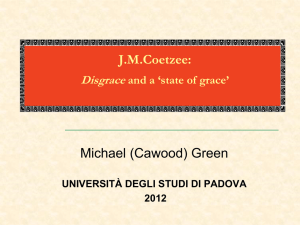
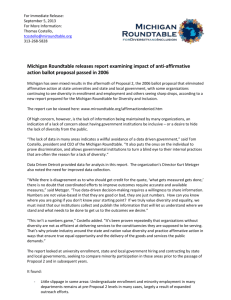
![Special Author: J M Coezee [DOCX 16.46KB]](http://s3.studylib.net/store/data/006725603_1-a90a37b51f13fcb8d2c12633d4a21525-300x300.png)
